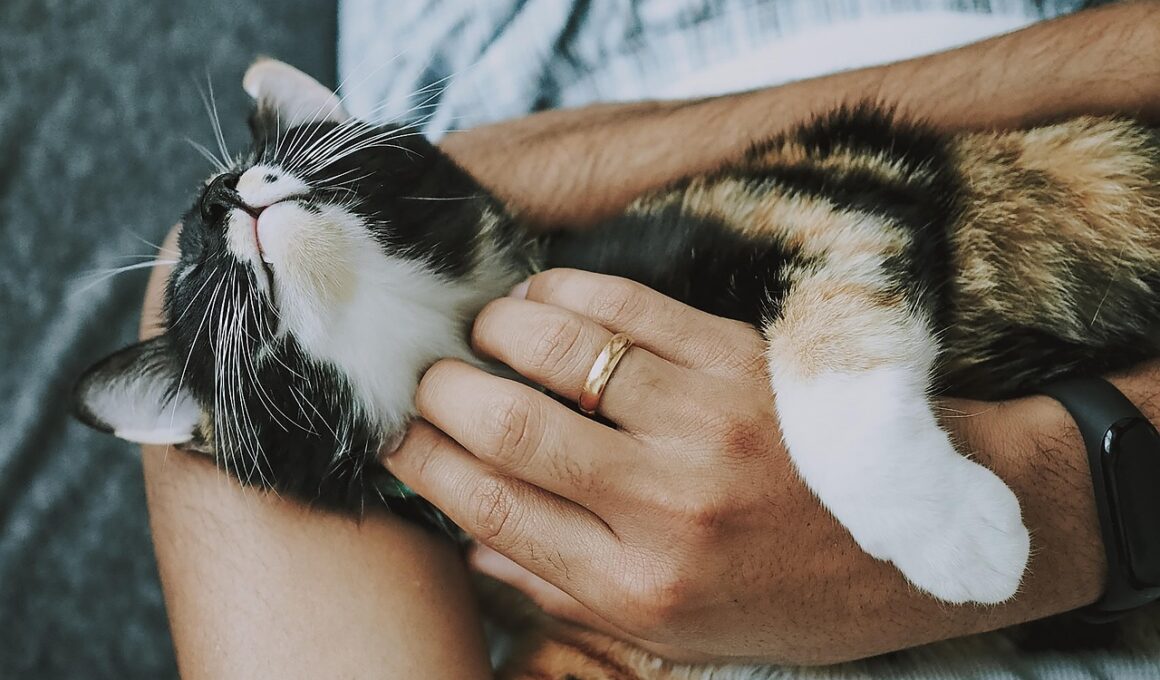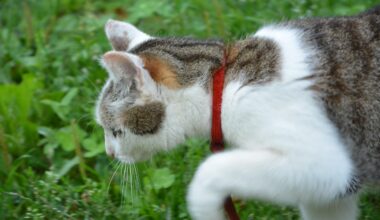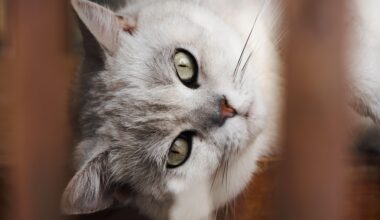Creating a Comfortable Living Space for Your Senior Cat
As cats age, their needs for comfort and security change significantly. It is crucial to provide an environment that promotes their well-being. Start by assessing your current living space and identifying areas that require adjustments. Ensure that your cat has easy access to essentials, such as food, water, and litter boxes. You can do this by lowering the height of any structures or using ramps for easy entry. Make sure you have cozy resting spots that offer warmth and support. A plush bed with raised edges can help your senior cat feel secure. Additionally, consider placing more resting places in different rooms, allowing your cat the freedom to roam while having a safe space to retreat. Think about utilizing a cat tree or shelves for climbing, but ensure they are safe and accessible. Engaging in play with toys designed for senior cats can also enhance their comfort. Overall, a well-planned living space with suitable adjustments can significantly contribute to their happiness and health, making a positive difference in their golden years.
Soft surfaces can be inviting for older felines, so adding carpets and blankets can be beneficial. Older cats may experience joint pain or arthritis, making hard flooring uncomfortable. Utilize cushioning around the house—using foam mats or plush carpeting can reduce strain on their joints. Ensure they have access to sunlight, where they can enjoy the warmth while feeling safe. Cats love to observe their surroundings, so providing a perch by the window can create a comfortable observation point. Also, consider creating cozy hideaways, such as cat tunnels or covered beds, where your senior cat can retreat when feeling overwhelmed. Place them in quiet areas away from noise and disruption. Limit the number of stairs in their daily routine to minimize physical strain. While climbing may be part of their instinct, limiting it can help reduce stress. Regular vet check-ups can also help monitor conditions that affect mobility and comfort. Your attention to your senior cat’s needs greatly enhances their living situation, affecting their health. Moreover, a well-organized comfortable living space fosters a stronger bond between you and your cherished feline companion.
Providing Essential Nutrition
Nutrition plays a key role in maintaining your senior cat’s health, directly impacting their comfort and vitality. Research indicates that as cats age, their dietary needs shift, requiring a diet rich in specific nutrients. Look for senior cat food that is high in protein to support muscle maintenance and overall health. Ensure the food is easy to chew, considering dental health may decline in older cats. Hydration is equally important; encourage water intake by providing fresh water daily and considering a cat water fountain. This can entice them to drink more. Additionally, consult with a veterinarian on dietary supplements that may benefit your senior cat’s specific conditions. If your cat has special needs, such as renal issues, tailored diets are available to manage these challenges. Monitor their weight closely, as obesity can worsen joint pain and affect mobility. Feeding smaller meals throughout the day rather than larger portions can create a more comfortable eating experience. It is essential to adapt their nutrition progressively, recognizing any shifts in their appetite or preference. Careful attention to your senior cat’s nutritional needs can greatly improve their quality of life as they grow older.
Health monitoring is crucial in creating a comfortable living space for your senior cat. Regular veterinary check-ups help identify potential issues early, allowing you to take prompt action. With age, common health issues arise, including arthritis, kidney disease, and hyperthyroidism. Early detection is key to managing these conditions effectively. Consider keeping a health diary for your feline, noting any changes in behavior, appetite, or mobility. Sharing this information with your vet will provide them with insights into your cat’s overall health status. This way, tailored care can be developed, ensuring your senior cat receives the best possible treatment plan. Additionally, physical activity should be encouraged in a safe and moderated manner. Gentle play and short, supervised sessions can keep their bodies active without overexerting them. Adapt your interactions to suit your cat’s needs, ensuring the activities are enjoyable and not strenuous. Provide scratching posts at a low height to assist with retention of muscle strength and flexibility. Regular grooming can also be comforting, as older cats may not groom themselves as effectively. Focus on creating a supportive and monitoring environment for ensuring optimal comfort.
Creating Interactive Spaces
Interactive spaces help combat boredom and stimulate your senior cat, which is key to their comfort and happiness. Cats are naturally curious creatures, and providing engagement keeps their minds sharp. Consider setting up various play areas in your home, incorporating toys that are safe and manageable for an older cat. Opt for interactive toys, such as wands with feathers or balls that move automatically, enticing them to explore. Ensure there are different types of toys available—some that encourage physical activity and others for passive play. Additionally, puzzle feeders can provide mental stimulation while ensuring your senior cat engages with their food in a fun way. Outdoor experiences can also be valuable; if your cat is comfortable, a secure outdoor space can introduce new sights and sounds. Leash training is worth considering if your cat is willing to adapt, providing safe outdoor exploration. Installing scratching surfaces in easy-to-reach locations can encourage natural behaviors while promoting their mental health. Encourage exploration by rotating toys regularly to keep their interest piqued. Focus actively on creating a home that engages your senior cat in safe, enjoyable ways.
Emotional well-being is vital for your senior cat, as companionship plays a significant role in their quality of life. Consider how you can foster emotional support through consistent contact and positive interactions. Spend dedicated time each day to cuddle, pet, or simply sit near your senior cat, allowing them to engage with you for comfort. This not only underscores the bond you share but also alleviates feelings of loneliness. Cats may experience anxiety as they age, making them more sensitive to changes in their environment. Keep noise levels low and maintain a stable routine to reduce stress. Additionally, providing a safe space for escape, with cozy spots they can retreat to, can offer comfort during overwhelming situations. Introducing calming elements, such as pheromone diffusers or calming collars, can help manage their anxiety. Be aware of how your cat interacts with your household environments; minimizing disruptions leads to a more secure atmosphere. Focus on creating a loving and stable environment while ensuring your senior cat feels cherished, celebrated, and safe. These efforts greatly enhance their emotional health and comfort throughout their senior years.
Conclusion: Enhancing Your Cat’s Golden Years
Enhancing your senior cat’s environment is crucial to improving their quality of life during their golden years. Focus on creating a comfortable living space while considering their physical, nutritional, and emotional needs. By adapting your home, investing in essential supplies, and fostering emotional connections, you create a sanctuary where your senior cat can thrive. Maintain a good relationship with your veterinarian to monitor changes in health and behavior, ensuring that potential problems are identified early. Regular interaction and routine in their daily lives help build a sense of security, allowing your cat to flourish. Engage in gentle play, provide suitable food options, and ensure regular health check-ups are part of your effort in enhancing their lifestyle. Recognizing their limitations allows for tailored adaptations to their environment, ensuring it meets their unique needs. Each small change can significantly impact their overall well-being. Ultimately, your efforts should aim to create a loving and supportive home where your senior cat can feel safe and secure while enjoying their companionship with you. This dedicated care fosters enhanced happiness, well-being, and comfort for your cherished feline friend.
[Include an image of a senior cat resting comfortably in a cozy space to visually represent the article.

